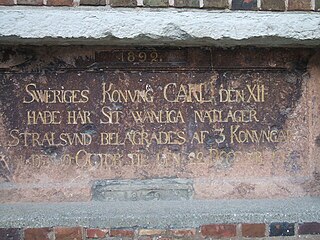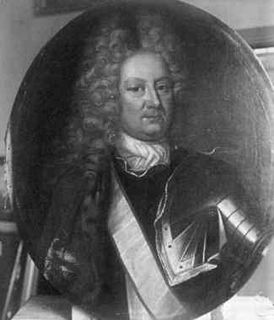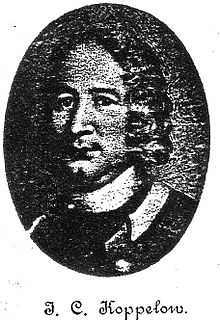
Margaret I was queen consort of Norway (1363–1380) and Sweden (1363–1364) and later ruler in her own right of Denmark, Norway and Sweden, from which later period there are ambiguities regarding her specific titles. She was the founder of the Kalmar Union, which spanned Scandinavia for over a century. Margaret was known as a wise, energetic and capable leader, who governed with "farsighted tact and caution," earning the nickname "Semiramis of the North". She was derisively called "King Breechless", one of several mean nicknames invented by her rival Albert of Mecklenburg, but was also known by her subjects as "the Lady King", which became widely used in recognition of her capabilities.

Sweden and Norway or Sweden–Norway, officially the United Kingdoms of Sweden and Norway, or as the United Kingdoms, was a personal union of the separate kingdoms of Sweden and Norway under a common monarch and common foreign policy that lasted from 1814 until its amicable and peaceful dissolution in 1905.

Fredriksten is a fortress in the city of Halden in Norway.

Peter Jansen Wessel Tordenskiold, commonly referred to as Tordenskjold, was a Norwegian nobleman and an eminent naval flag officer in the service of the Royal Dano-Norwegian Navy. He rose to the rank of Vice-Admiral for his services in the Great Northern War. Born in Trondheim, Peter Wessel travelled to Copenhagen in 1704, and was employed in the navy. He won a name for himself through audacity and courage, and was ennobled as Peter Tordenskiold by King Frederick IV in 1716. His greatest exploit came later that year, as he destroyed the supply fleet of Charles XII of Sweden at the Battle of Dynekilen. In 1720, he was killed in a duel. In Denmark and Norway he is among the most famous national naval heroes. He experienced an unusually rapid rise in rank and died when he was only 30 years old.

Princess Märtha of Sweden was Crown Princess of Norway as the spouse of the future King Olav V from 1929 until her death in 1954. The presently reigning King Harald V is her only son. Märtha was also a maternal aunt of Baudouin of Belgium and Albert II of Belgium.
Haakon Sverresson was King of Norway from 1202 to 1204.

The Great Northern War was the war fought between a coalition of Denmark–Norway, Russia and Saxony-Poland on one side and Sweden on the other side from 1700 to 1721. It started by a coordinated attack on Sweden by the coalition in 1700, and ended 1721 with the conclusion of the Treaty of Nystad, and the Stockholm Treaties. As a result of the war, Russia supplanted Sweden as the dominant power on the shores of the Baltic Sea, becoming a major player in European politics.

The Scanian War was a part of the Northern Wars involving the union of Denmark–Norway, Brandenburg and Sweden. It was fought from 1675 to 1679 mainly on Scanian soil, in the former Danish provinces along the border with Sweden and in Northern Germany. While the latter battles are regarded as a theater of the Scanian war in English, Danish and Swedish historiography, they are seen as a separate war in German historiography, called the Swedish-Brandenburgian War.
Active warfare throughout recorded history has predominantly involved male combatants; however, women have also contributed to military activities including as combatants. The following list describes women known to have participated in military actions in the 18th century.

The Siege of Stralsund was a battle during the Great Northern War. The Swedish Empire defended her Swedish Pomeranian port of Stralsund against a coalition of Denmark-Norway, the Electorate of Saxony and the Tsardom of Russia, which was joined by the Kingdom of Prussia during the siege.

Johan Gustaf Renat (1682–1744) was a Swedish soldier and cartographer. He is mainly known for his role in bringing detailed maps of Central Asia to Europe after close to two decades in captivity.

Brigitta Christina Scherzenfeldt, as married Bernow, Lindström, Ziems, and Renat, was a Swedish memoirist and weaving teacher who was captured during the Great Northern War and lived as a slave in the Dzungar Khanate in Central Asia. She dictated her memoirs, describing her life as a slave, after her release. Her story is regarded as a unique source of information about life among the Dzungars.
Vincens Budde was a Norwegian officer, born in 1660 in Halden, Norway into a Norwegian military family. Budde was promoted to colonel 1710 and to major general in 1716.

Caspar Herman Hausmann was a Danish-Norwegian General, lumber merchant and squire. He was born 10 January 1653 at Segeberg in the Danish duchy of Holsten, which was then in union with Denmark-Norway. He died 9 September 1718 in Christiania and lies in a crypt in Oslo Cathedral. He was married to Karen Nielsdatter Toller (1662–1742). He was a half-brother by Margaret Pape with Ulrik Frederik Gyldenløve (1638–1704) — Gyldenløve was King Frederick III of Denmark's acknowledged illegitimate son and Statholder (viceroy) to Norway from 1664 until 1699.
Anna Paulsdatter Krefting née Vogt (1683-1766), was a Norwegian businesswoman who ran and expanded her family's business enterprises in and around Christiania for over 50 years. Among these enterprises were mines and ironworks, forestry, and trade.

Anna Colbjørnsdatter Arneberg (1667–1736) was a Norwegian national heroine who was most known for her participation in the Battle of Norderhov during the Great Northern War.

The Siege of Fredriksten was an attack on the Norwegian fortress of Fredriksten in the city of Fredrikshald, (now Halden) by King Charles XII of Sweden. While inspecting his troops' lines, Charles XII was killed by a projectile. The Swedes broke the siege off, and the Norwegians held the fortress. Alongside with the Treaty of Nystad three years later, the death of Charles XII marked the end of the imperial era in Sweden, and the beginning of the Age of Liberty in that country.

Jürgen Christoph von Koppelow or Jørgen Christopher von Koppelau (1684–1770) was a Norwegian nobleman and officer that fought in the Great Northern War on behalf of Denmark–Norway. Von Koppelow was the son of Curt Christoph von Koppelow, a German-Norwegian nobleman from the House of Koppelow in Mecklenburg-Schwerin. Von Koppelow led the Norwegian Army's 3rd Søndenfjeldske Dragoon Regiment upon its establishment in 1750.















